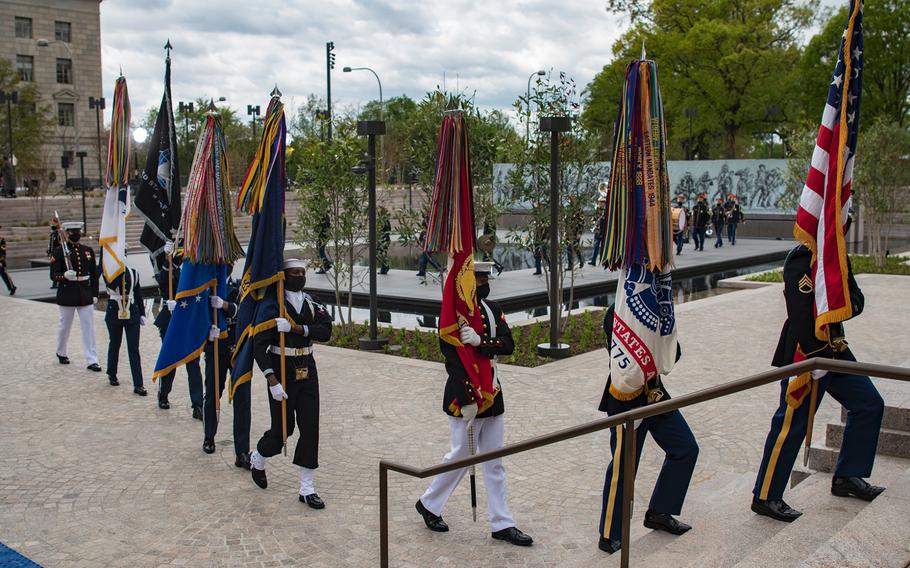
Members of a military ceremonial honor guard march off followed by members of the U.S. Army Band "Pershing's Own" at the conclusion of a dedication ceremony for the World War I Memorial in Washington, D.C. on Friday, April 16, 2021. (Carlos Bongioanni/Stars and Stripes)
WASHINGTON — It’s officially open, but the new World War I Memorial in the nation’s capital is far from complete.
The central design element for the $42 million memorial is a roughly 60-foot long, 12-foot high sculpture wall that will feature nearly-life-size men and women, depicting various aspects of wartime life. But the sculptures won’t be completed and added to the wall until 2024. In the meantime, a canvas with artists’ sketches of the future sculpture hangs on the wall.
The site for the new memorial was previously known as Pershing Park, and some elements of the old park have been preserved and incorporated into the new. A statue of Gen. John J. Pershing and two memorial walls with engravings of pertinent information about the war remain on the southeast corner of the memorial. Known as the General of the Armies, Pershing returned home a national hero after he commanded the American Expeditionary Forces on the Western Front in World War I.
When Pershing Park was built, the general was the main focus of the park named after him. The new memorial seeks to expand the scope of the tribute to include a broad array of people who served during the war.
In a “first Colors” ceremony on Friday, the U.S. flag was raised over the site for the first time, as the former city park took on an elevated status as a “National” memorial, although the National Park Service will not be responsible for the memorial’s upkeep.
The U.S. Army Band “Pershing’s Own” and a ceremonial military honor guard were on hand as military members raised the flag, and an Army musician played taps on a bugle that belonged to Gen. Pershing. Soon after, two F-22 Raptors roared overhead to pay tribute.
Attendees at Friday’s event were treated to about an hour of prerecorded remarks from celebrities, politicians and a number of influential people who helped bring the memorial to fruition. President Joe Biden noted how fitting it was to recognize the sacrifice of those who went through the “horror” of a war that involved, among other things, chemical weapons and gruesome fighting from trench to trench.
“In some ways, the Great War shifted America’s thinking about ourselves and redefined our place in the world,” Biden said.
Marine veteran Chris Kuhns and his wife, Gabrielle, volunteered to attend the event as World War I reenactors. He wore a WWI-era Marine Corps uniform, while she wore an outfit to portray a Salvation Army Doughnut Girl.
“This is incredibly important to both of us. We both have family members who fought in the war,” said Chris Kuhns.
Gabrielle Kuhns noted that her great, great grandfather served in Pennsylvania’s 28th Division and was wounded in Chateau Thierry in July of 1918.
The Kuhns both found it remarkable that up until Friday, Washington, D.C., did not have a national memorial to honor the those who served in World War I.
The National WWI Museum and Memorial in Kansas City, Mo., has served the public as an official national museum since 2004, but this is the first time the nation's capitol has such a site specifically dedicated to World War I.
Of the roughly 4.7 million Americans who fought in the war from April 1917 to November 1918, nearly 117,000 were killed and about 320 became sick or wounded.
“Everyone always thinks of World War II, and we were in it for four years, and it was a super bloody war," said Chris Kuhns. "But if you look at the casualty rates of World War I, we had a higher death rate in one year of fighting … then the bloodiest year in World War II. It’s just a very underrated war, something people just don’t talk about a whole lot,
“Just the fact that they are putting a monument in, is very important, jut to uphold the legacy of the men and women who were in France during World War I.”